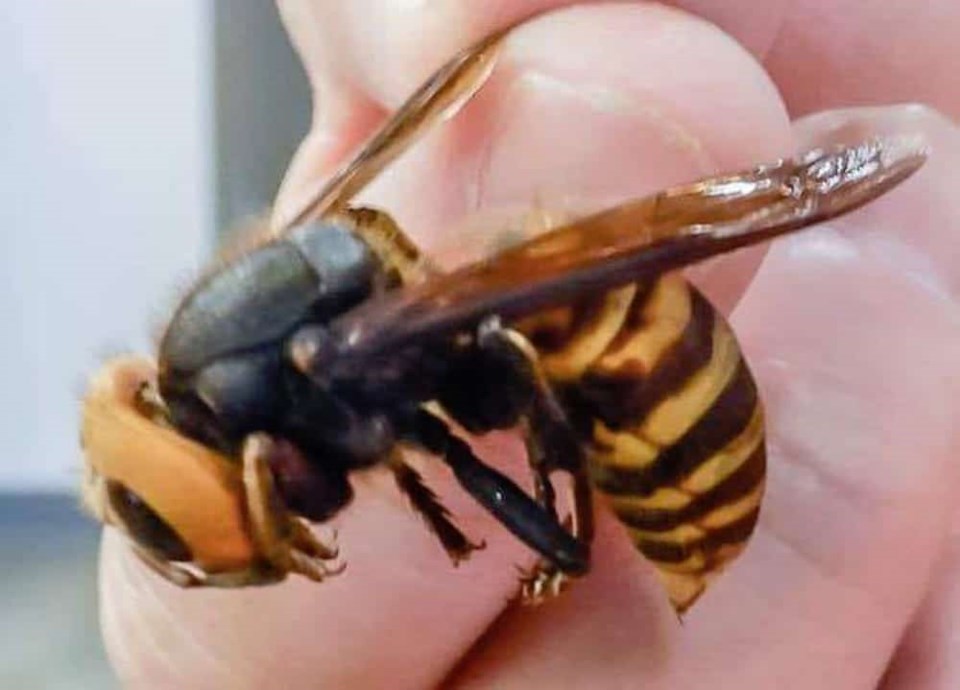With a wingspan of four to seven centimetres, as well as a potent sting that purportedly feels like a 'red-hot thumbtack,' it is no wonder why locals fear the spread of the Asian Giant Hornet.
An invasive species, the Asian Giant Hornet (Vespa mandarinia), is commonly referred to as the 'murder hornet.' Normally found in the forests and low mountains of eastern and southeast Asia, it remains unclear how they arrived in North America. Their moniker — perhaps better suited for a comic book title or rock band name — was coined in Japan.
Three Asian giant hornets were spotted in B.C. for the first time last August in the Nanaimo area, the province’s agriculture ministry said. The single nest was spotted and destroyed, but a specimen was found last November in White Rock and two specimens were found in December at Blaine, Washington.
British Columbia classifies the Asian giant hornet as a “serious honey bee predator.”
Now, Provincial Apiculturist Paul Van Westendorp states that a specimen has been identified and collected in the Fraser Valley.
In a Facebook post, beekeeper Laura Delisle shares a photo of a thumb-sized hornet. She also includes a letter from Van Westendorp, which states that a specimen was found just south of Langley.
"The specimen will be subject to an autopsy and DNA sequencing to determine its caste (~queen or worker) and its Asian origin," writes Van Westendorp.
"Until now, the only confirmed cases on the mainland included a single specimen in White Rock and two specimens near Blaine WA."
VanWestendorp remarks that the latest find indicates that the hornets may have established nests farther into the Fraser Valley than had been anticipated.
"It is expected that more sightings will be reported in the coming months," he adds. "As nests increase in size, AGH is expected to increase its predation on honeybees."
While AGHs pose a serious threat to honey bees, experts say they don't pose a serious threat to humans. They hunt insects and are generally not looking to engage with people, pets or large animals, the B.C. Agriculture Ministry said. That said, you should still exercise caution around the predatory insects. Multiple stings may cause serious allergic reactions that require medical attention.
Disturbing a nest, however, will put them on the attack. And a sting packs a mighty wallop.
A Vancouver island man says the sting felts as though hot thumbtacks had been stuck into his leg. Further, he experienced “throbbing muscular aches” in the legs for about 24 hours.
The buzz about Asian giant hornets
• If you find a nest, do not disturb it. Leave the area.
• Stings are rare but could occur if the nest is disturbed.
• Because of the larger amount of venom injected, a sting can be very painful and cause localized swelling, redness and itching.
• Treat a sting similar to wasp or bee stings by putting ice or a cold compress on the site to reduce inflammation and spread of venom.
• Do not rub the site because it will spread venom.
• People who are stung multiple times (10 or more) have a higher risk of developing toxic or allergic reactions, lightheadedness or dizziness.
• People who are stung multiple time or who develop symptoms of toxic or allergic reactions are advised to seek medical attention immediately.
• If you think you’ve spotted an Asian giant hornet, call the Invasive Species Council of B.C. at 1-888-933-3722, or via the council’s “Report Invasives” mobile phone app, or online HERE.
- With files from Carla Wilson / The Times Colonist and The Canadian Press.



